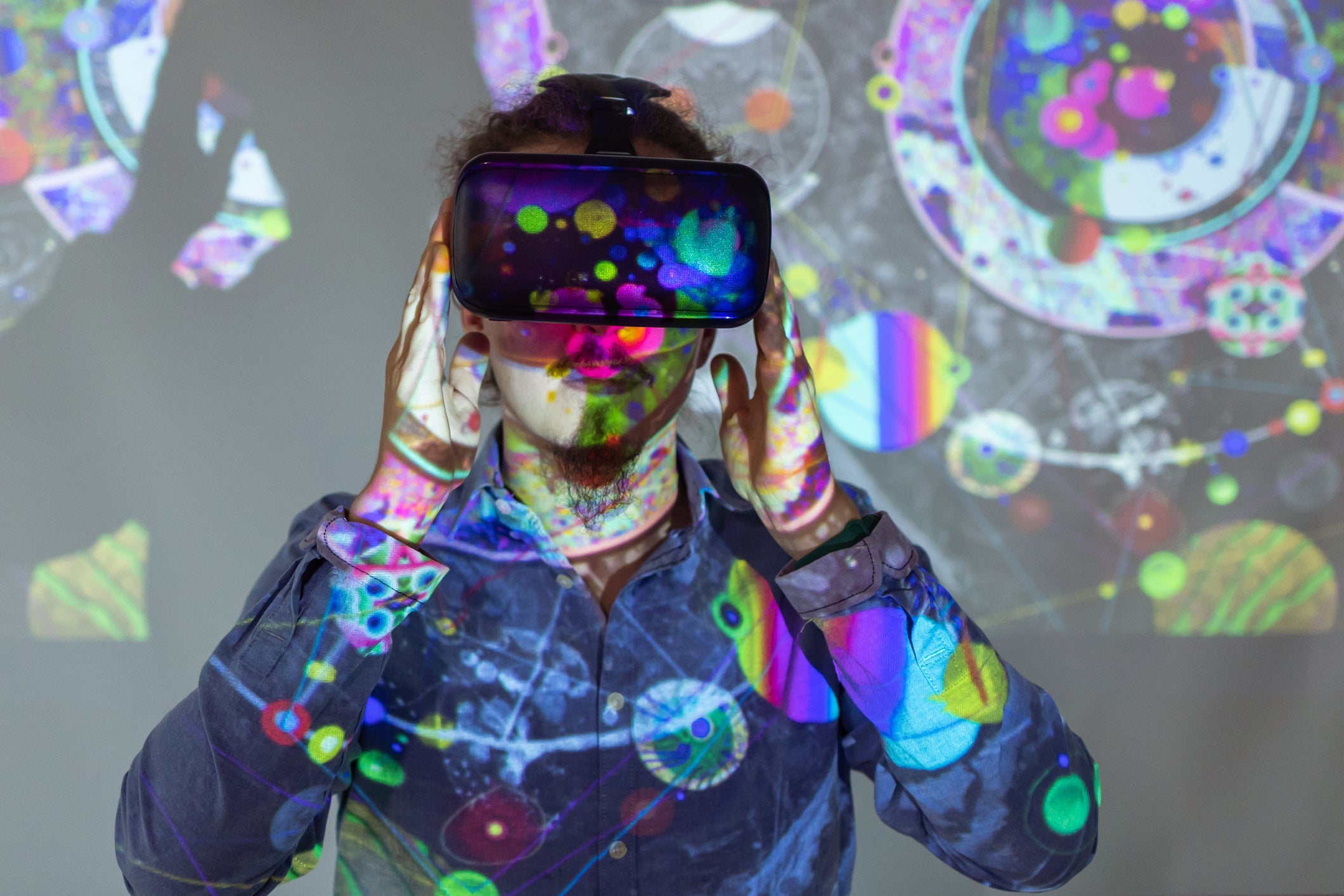Why does everything have to be an immersive experience now?
From interactive theatre shows to themed escape rooms, immersive events have never been harder to dodge. Katie Rosseinsky investigates how they mounted a hostile takeover of our social lives
If you’re already embroiled in the process of fine-tuning your summer plans, then you might have noticed a recurring theme. Perhaps you’ve seen an advert for a splashy new exhibition that promises to bring together multiple masterpieces by legendary artists “like you’ve never seen them before”… in a warehouse space half an hour out of town. Or you’ve had your interest piqued by a new theatre production, only to read the small print and learn that the show involves being chased through dark corridors by drama students. Maybe your most enthusiastic friend is trying to persuade you to join them in a “life-sized”, IRL version of a board game that surely no one actually likes.
Whether you’re trying to enjoy a vaguely cultural day out, partake in a bit of organised fun or simply grab a drink, you need to remain vigilant, because you’re at high risk of being “immersed”. In 2025, even the most mundane events and venues have somehow been rebranded as “immersive experiences”, promising to draw the visitor into a magical new world (and make them forget that they’re actually in an out-of-town shopping centre, next to a deserted bowling alley). Just want to enjoy a painting or an exhibition in a straightforward way? Not allowed, sorry. You must pull on a virtual reality headset and be immersed.
Just take a look at some of the big new events that have recently set up around the country, or are just about to open their doors. Fans of the dystopian TV drama Squid Game, in which desperate contestants risk death to play creepy childhood games and vie for a huge jackpot, can take part in the very same tasks at Squid Game: The Experience at ExCel London (without the high stakes of being killed when you mess up, of course). If you prefer mind games, you can book in for The Traitors Live Experience, based on the BBC reality show, which launches in Covent Garden in July. Or maybe you’d rather head to “The Legend of the Titanic”, an immersive exhibition dedicated to the ill-fated ship (as for whether we should really be immersing ourselves in a mass tragedy? That’s a murky ethical question for another day).
The scourge of interactivity is at its worst in London, but it has started to encroach on the rest of the country, too. Countless variations on the now-ubiquitous “Van Gogh Experience” have cropped up from Aberdeen to Birmingham, allowing art fans to wander round cavernous conference centres while being bombarded with scaled-up projections of iconic paintings such as Sunflowers and Starry Night (just as the post-Impressionists intended). And countless themed escape rooms and novelty bars (such as the Alcotraz chain, designed to recreate the experience of drinking contraband in a US jail) seem to be cropping up on a regional high street near you, often taking over units left empty by the downfall of yet another retail stalwart.
If you assumed this was a phenomenon solely directed at millennials with disposable income, think again: the children of said millennials are emerging as a fresh target, being primed for a lifetime of underwhelming immersive experiences from a tender age. By the end of the year, parents and kids will be able to visit events dedicated to the two animal overlords of British twee: Paddington Bear and Peppa Pig. The marmalade fiend has already set up residence at County Hall on London’s Southbank, a stone’s throw from the “swamp-tastic” Shrek’s Adventure experience. Peppa Pig’s Surprise Party event, meanwhile, will open at the Metrocentre in Gateshead in the autumn, promising the “unprecedented opportunity to interact directly” with Peppa’s ever-expanding family of cartoon swines.
Of course, these events wouldn’t be proliferating at quite such a breakneck speed if the ticket-buying public weren’t on board. In 2024, ticket platform Eventbrite reported that searches for “immersive experiences” had shot up by 83 per cent over the course of the previous year; DesignMyNight, another booking platform, also saw an 88 per cent increase in interest year on year. The global market for immersive entertainment has been valued at £98bn, projected to rise to £351bn by the start of the next decade. That’s a lot of tickets to Mamma Mia!: The Party (a night out based around the film and the West End show, based in turn on the music of Abba).

So what’s the problem here, you ask? Why not just let people enjoy an evening wandering around a mocked-up prison wearing orange jumpsuits, if that’s how they wish to spend their time and money? You could also argue that these shows might be an entry point for introducing new audiences to art and theatre. My issue is that, for the most part, “immersive” experiences have become a case of diminishing returns.
Now that event organisers have latched on to the fact that they can hike up their prices significantly if they stick this buzzword somewhere in their event description, everything has started claiming to be immersive. An escape room with a set more befitting a school play? Yep, immersive. An underwhelming pop-up in a pub garden, solely comprising a flower wall? That’s immersive, too. An overhead projector blasting out pixelated renditions of beloved artworks that spiral around the room like an old Windows screensaver? Immersive, apparently.
In 2024, ticket platform Eventbrite reported that searches for ‘immersive experiences’ had shot up by 83 per cent over the course of the previous year
I haven’t always been such a hater. Rewind 10 years or so and you’d find me blithely parting with inflated sums of money to attend, say, a Secret Cinema recreation of the Catskills holiday camp from Dirty Dancing because Time Out told me it’d be worth it (I spent most of the night queueing for the women’s loos; somehow, I don’t think the organisers had foreseen how vastly female guests would outnumber male ones). I’d at least have a go at getting tickets for whatever Yayoi Kusama exhibition everyone else was posting about on Instagram. I drew the line at that “potions” themed bar, though, where about 70 per cent of each drink seemed to consist of dry ice. But back then, there was at least some level of, well, immersion associated with so-called immersive events. The production values were solid. Effort had been put in. They were cash grabs, sure, but the grabbing didn’t feel quite as blatant.
Now, though, most of these events are organised with all the flair and attention to detail of a task on The Apprentice (incidentally, recent seasons of that show have seen Lord Sugar’s candidates attempt to dream up their own immersive experiences and virtual escape rooms, which speaks volumes). They don’t spark imagination; instead, they seem to have been designed with as little space for actual creativity as possible. It’s giving properly groundbreaking immersive art and performance a bad name, tarring it with the same naff brush.

The immersive bubble should have burst at the start of last year, when the ne plus ultra of god-awful “experiences” made headlines around the world. In February 2024, unsuspecting families headed off to a barren warehouse in Glasgow, hoping to be ushered into a world of pure imagination at a Willy Wonka-inspired event. The word “inspired” was perhaps the first sign that something was awry; this calamity had precisely zero to do with Roald Dahl or any Wonka adaptations. Instead, they were met with a few lacklustre candy cane decorations and some depressed aspiring actors dressed as Oompa-Loompas. Children were left traumatised; parents called the police. The footage, which I’m sure you’ve seen by now, went viral. The whole affair felt like a cautionary tale about the risk of falling for a colourful, AI-made event listing on Facebook.
It’s giving properly groundbreaking immersive art and performance a bad name, tarring it with the same naff brush
For those who looked on from afar (if not for the actual ticket holders), it was all pretty amusing. It seemed to perfectly illustrate the “emperor’s new clothes” vibe of this genre of events, albeit in a highly exaggerated, almost hallucinatory way. But the Willy Wonka debacle didn’t kill off the experiential event. Far from it. In fact, it feels like now it’d take a lot more than an apparently ChatGPT-generated script and a few handfuls of jellybeans to bring down this industry. And yet, assuming that we need to be lured in by gimmicky novelties and flashing lights does us all a disservice; at its worst, it stops us from actually engaging with what’s in front of us in a more considered, personal manner. It’s a gamified and weirdly flat way of experiencing things.
Call me a killjoy if you will, but chucking in some wall projections and staff doing dodgy accents doesn’t necessarily add something to every experience. We don’t need to be coerced into participating in some expensive am-dram to enjoy things. It’s about time we recognised that “immersive” is not a like-for-like substitute for “interesting”. And please, no more VR headsets.
Join our commenting forum
Join thought-provoking conversations, follow other Independent readers and see their replies
Comments